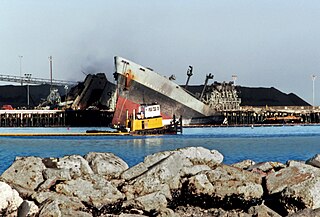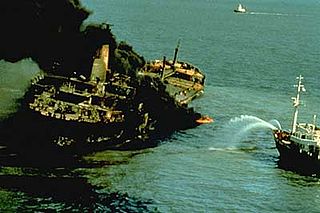Related Research Articles

USS Abner Read (DD-526) was a Fletcher-class destroyer in the service of the United States Navy, named after Lieutenant Commander Abner Read, who fought in the American Civil War. The ship fought in World War II, seeing action in the Aleutian Islands Campaign and in 1943 she survived hitting a mine that blew off her stern. After repairs, she returned to service and operated in support of Allied forces in the New Guinea campaign and the Battle of Leyte. She was sunk in an air attack off Leyte on 1 November 1944.

USS Mississinewa (AO-59) was the first of two United States Navy ships of the name. She was a T3-S2-A1 auxiliary oiler of the US Navy, laid down on 5 October 1943 by the Bethlehem Sparrows Point Shipyard, Inc., Sparrows Point, Maryland; launched on 28 March 1944; sponsored by Miss Margaret Pence; and commissioned on 18 May 1944. Mississinewa was commanded by Captain Philip G. Beck. The ship is named for the Mississinewa River of eastern Indiana.

The Economic Development Board (EDB) is a statutory board under the Ministry of Trade and Industry of the government of Singapore that plans and executes strategies to sustain Singapore as a leading global hub for business and investment.

SS Sansinena was a Liberian oil tanker that exploded in Los Angeles harbor on 17 December 1976 at 7:33pm. She was docked at berth 46 at Port of Los Angeles in San Pedro, California.
The following lists events that happened during 1968 in Singapore.

An oil tanker, also known as a petroleum tanker, is a ship designed for the bulk transport of oil or its products. There are two basic types of oil tankers: crude tankers and product tankers. Crude tankers move large quantities of unrefined crude oil from its point of extraction to refineries. Product tankers, generally much smaller, are designed to move refined products from refineries to points near consuming markets.
Esso Brussels was a commercial oil tanker built for the Esso Oil company in 1959. She was involved in a collision in 1973 in which thirteen of her crew perished. She was rebuilt and sailed under various other names until being scrapped in 1985.

414N Russian: 414Н is a river tank ship class, developed in Russia in 1962. The class 414 is one of the classes of the SPN ship project. These tankers have capacity of 600 tons and are used for oil transportation on the superficial rivers of Siberia.
Sea Witch was a MARAD Type C5-S-73b container ship built at the Bath Iron Works shipyard for American Export-Isbrandtsen Lines. She operated in the Atlantic trades for five years. So engaged on the evening of June 1, 1973, the vessel was involved in a disastrous collision with the oil tanker Esso Brussels in lower New York Harbor and was damaged so badly that she was removed from active service.

MT Burmah Agate was an oil tanker that was involved in a nautical collision and subsequent oil spill near Galveston, Texas in November 1979. 31 crewmen were killed in the collision, and the oil spill damaged the local environment.
The Venpet–Venoil collision was a maritime accident involving sister supertankers; the Liberian-registered Venoil and Venpet, in dense fog off the coast of South Africa on 16 December 1977. The tankers were travelling in opposite directions; the Venoil fully laden with over 250,000 tonnes of crude oil bound for Halifax, Canada, and the Venpet, travelling in ballast, headed for Kharg Island, Iran. The Venoil ploughed into the Venpet, eventually leading to the spilling of approximately 26,600–30,500 tonnes of crude oil. The tankers were sister ships owned and operated by Bethlehem Steel Corporation. Both ships were crewed by Taiwanese sailors.
MV Dromus was a 1930s British oil tanker owned by Anglo-Saxon Petroleum, a British subsidiary of Royal Dutch Shell. She was launched in September 1938 by Harland and Wolff at Belfast in Northern Ireland. She was one of a class of 20 similar tankers built for Anglo-Saxon.

The Nimbin was a steel screw steamer built in 1927 at Copenhagen, that was the first motor vessel placed into the New South Wales coastal trade. It was owned and operated by the North Coast Steam Navigation Company and was the first Australian registered merchant ship to be lost during World War II when it struck a mine laid by the German auxiliary cruiser Pinguin. The Nimbin was on its way from Coffs Harbour to its home port, Sydney, with a cargo of bundled three-ply timber and a cargo of pigs. One third of the ship was blown away and it sank in three minutes. Seven men were killed. The remaining thirteen clung to bundles of plywood. Some hours later an air force plane from RAAF Base Rathmines saw the survivors and directed the coastal ship SS Bonalbo to the scene to retrieve them.
MV C.O. Stillman was an oil tanker that was built by a German shipyard in 1928 for a Canadian-based shipping company. A Panamanian subsidiary of Esso bought her at the end of 1936 and she was sunk by the German submarine U-68 in the Caribbean on June 4, 1942 about 41 nautical miles (76 km) southwest of Isla de Mona, Puerto Rico.
In June 1966, the British oil tanker MV Alva Cape caught fire twice in New York Harbor, first in a collision with tanker SS Texaco Massachusetts, and next while unloading cargo, and was subsequently scuttled offshore. Thirty-three people were killed in the collision, the resulting spill of its cargo of naphtha and major fire that ensued. Four more were killed about two weeks later while the emptied tanks were being inerted with carbon dioxide in a misguided attempt to make the damaged vessel safe for transport.
Silverlip was a steam tanker built in 1902 by the W.G. Armstrong, Whitworth & Company of Walker for Sir Marcus Samuel owner and chairman of Shell Transport & Trading Company of London. The ship was designed and built to carry liquid cargo and spent her career carrying petroleum products from Borneo and Texas to United Kingdom and Europe.

Samuel Q. Brown was a steam tanker built in 1920–1921 by Merchant Shipbuilding Corporation of Chester for Tide Water Oil Co., a subsidiary of Standard Oil, with intention of operating between New York and the oil-producing ports of the southern United States and Mexico.
India Arrow was a steam tanker built in 1921 by Bethlehem Shipbuilding Corporation of Quincy for Standard Oil Co., with intention of transporting oil and petroleum products between the United States and the Far East. During the first eight years the tanker was chiefly employed in the Pacific trade, carrying cargo between Gulf ports and a variety of destinations in East Asia. In late 1920s the tanker was moved to serve intercoastal trade routes while still making occasional trips to Asia. In early 1930s she was permanently assigned to trade routes between the Gulf and the ports on the United States East Coast, where she remained for the rest of her career.
R. W. Gallagher was a steam turbine-powered tanker built in 1938 by Bethlehem Shipbuilding Corporation of Quincy for Standard Oil Company of New Jersey with intention of operating between the oil-producing ports of the southern United States and Mexico and the Northeast. The tanker spent her entire career in coastwise trade and was torpedoed and sunk on one of regular journeys in July 1942 by German submarine U-67.
References
- ↑ "48 die in ship blast horror". Singapore Press Holdings. Archived from the original on 12 January 2008. Retrieved 15 January 2008.
- ↑ "Hundreds join rush to give blood to injured". eresources.nlb.gov.sg. Retrieved 19 October 2021.
- ↑ Singapore, National Library Board. "The explosion and fire on board S.T. Spyros, 12th October 1978 : the inquiry report". eservice.nlb.gov.sg. Retrieved 1 October 2018.
- ↑ "Spyros accident | Infopedia". eresources.nlb.gov.sg. Retrieved 19 October 2021.